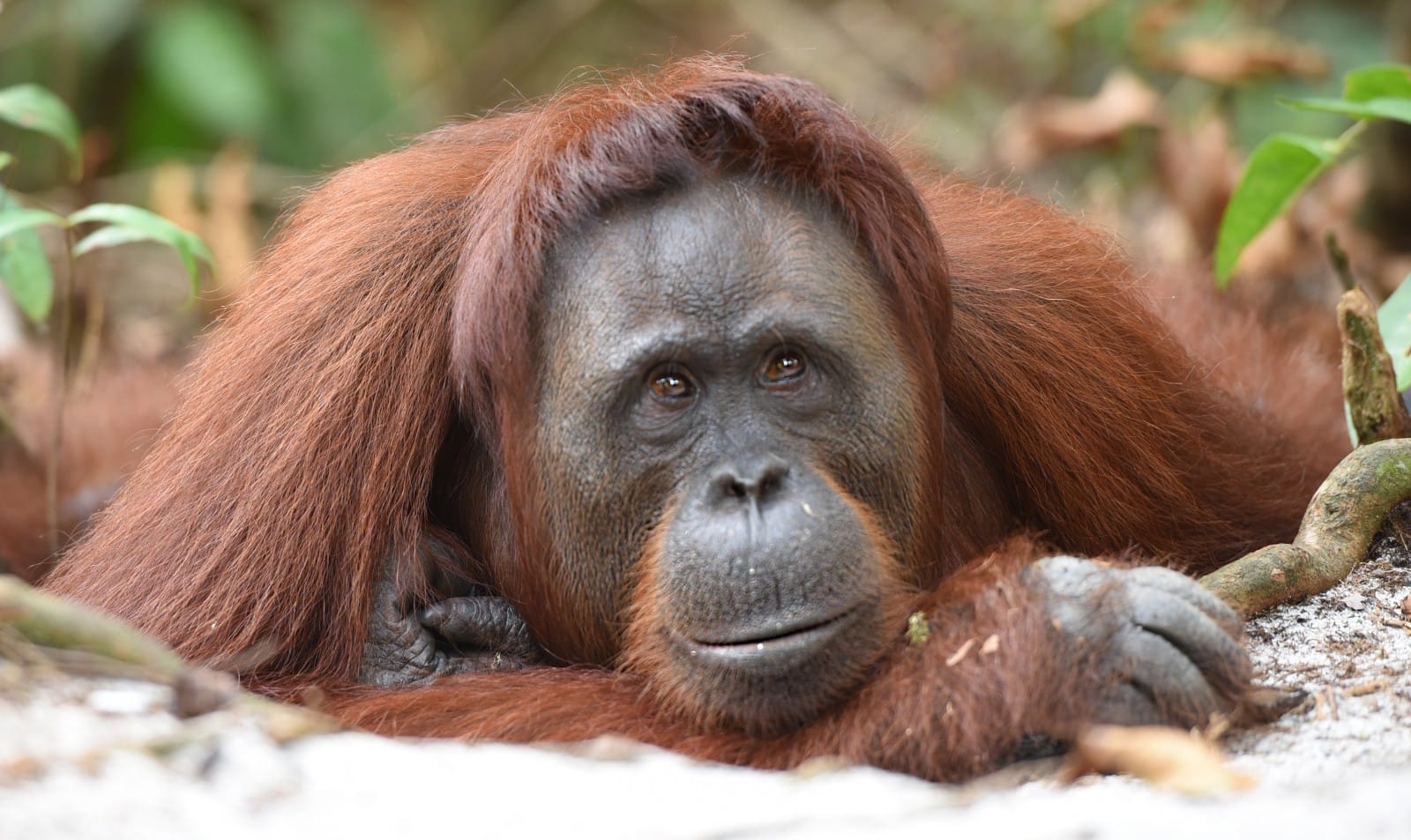Get ready for an incredible adventure into the amazing world of orangutans! We’re about to tell you 10 fun and eye-opening facts about these rainforest gems. From their love of plants to the threats they face, we’ll uncover the secrets of these gentle giants. So, sit back, relax, and let’s dive into the fascinating world of orangutans!
10 Fun Facts About Orangutans
Orangutans are fascinating creatures! Here are 10 cool things you should know about these amazing apes:
- Kings of the Canopy: Orangutans are the largest mammals on Earth that live their entire lives in trees! They are basically real-life versions of King Louie from The Jungle Book, but way less musical. Their bodies are built for clinging and swinging through branches, making them the ultimate treetop acrobats.
- Arm Envy: Ever wish your arms were longer than your legs? Well, that’s just everyday life for an orangutan! Their impressive arm span, which can reach up to 7 feet, helps them effortlessly navigate the forest canopy. It’s like having built-in grappling hooks!
- Cheeky Charmers: Male orangutans have these big, fleshy cheek pads called flanges, and they’re not just for show. Scientists believe these flanges amplify the males’ calls, making their voices boom through the forest and, hopefully, impressing the ladies. They also have a throat pouch that acts like a resonating chamber, adding to their vocal talents.
- Practically Family: Get this – orangutans share nearly 97% of their DNA with humans! That means they are some of our closest living relatives, even closer than gorillas. So next time you see an orangutan, remember, you’re looking at a distant cousin!
- Laid-Back Parents: Orangutan moms believe in quality over quantity. They usually only have one baby every eight years or so, which is the longest time between births of any mammal on Earth! This slow reproductive rate allows them to invest a lot of time and energy in raising their young.
- Master Builders: Forget treehouses, orangutans build tree-mansions! Every night, they craft elaborate nests high in the canopy using branches and leaves. These nests provide a safe and comfortable place for them to sleep and raise their young, away from predators.
- Smarter Than Your Average Ape: Orangutans are incredibly intelligent. They’ve been observed using tools like sticks to fish out insects from tree bark and using leaves as umbrellas to stay dry in the rain. Some scientists believe that they may even possess a form of culture, passing down knowledge and traditions from one generation to the next.
- Chatty Catamounts: Orangutans are surprisingly talkative! They communicate with each other using a variety of sounds, from grunts and growls to loud, long calls that can be heard for miles. But their communication isn’t limited to sounds – they also use facial expressions and gestures to get their point across.
- Musical Tastes: Believe it or not, orangutans seem to have a thing for music! Studies have shown that they react differently to different types of music, showing a preference for certain melodies and rhythms. Maybe they just appreciate a good beat!
- In Need of Our Help: Sadly, despite their intelligence and adaptability, orangutans are facing a real crisis. Their forest homes are being destroyed at an alarming rate due to deforestation, and they are also threatened by poaching and the illegal pet trade. It’s up to us to protect these amazing creatures and ensure their survival for generations to come.
What are 2 Things that Orangutans Eat?
We know these amazing orangutans are practically pros at navigating the rainforest, but have you ever wondered what fuels their adventures up in the canopy? Their diet is as diverse and fascinating as their treetop homes!
- Fruits: Fruits are like their absolute favorite thing in the world – think of it as their version of pizza! We’re talking delicious durians, yummy rambutans, classic bananas, and even coconuts! These fruits don’t just taste great; they give orangutans all the energy and vitamins they need to swing through the trees all day long.
- Leaves: It’s not all about fruit, though. They also munch on leaves from all sorts of trees and plants. Think of leaves like their veggies – they may not be as exciting as fruits, but they’re super important! They provide fiber, minerals, and antioxidants, which are like superpowers for their bodies.
Orangutans are incredibly smart and resourceful when it comes to finding food. They use their long arms and feet like tools, reaching for fruits and leaves way up high. And those incredible opposable thumbs? Those come in handy for grabbing and peeling their food with expert precision.
Scientists are still learning so much about these incredible creatures, and understanding their diet gives us a peek into their world and why protecting their rainforest home is crucial for their survival.
How many orangutans were there 10 years ago?
It’s tough to say for sure exactly how many orangutans were around a decade ago. Scientists were already deeply worried about their populations then, and the best estimates at the time suggest there were somewhere around 100,000. Keep in mind, counting orangutans in dense rainforests is no easy task! Sadly, we know those numbers have plummeted since then. Today, experts believe there might be only around 60,000 orangutans left in the wild. That’s a massive drop, and it paints a pretty scary picture for the future of these amazing apes.
Why the huge decline? The main culprits are habitat destruction (vast areas of rainforest being cut down for things like palm oil plantations), poachers who illegally hunt them, and the cruel illegal pet trade, which rips baby orangutans away from their mothers. It’s a heartbreaking situation.
The good news is that there are some incredibly dedicated people and organizations out there fighting tooth and nail to protect orangutans. They’re working on things like establishing protected areas, raising awareness about the plight of orangutans, and cracking down on those involved in illegal activities. But they can’t do it alone. We all need to learn more about these incredible creatures and support efforts to ensure their survival.
What are the sad facts about orangutans?
It’s heartbreaking to think about what orangutans, our close relatives in the animal kingdom, are going through. Imagine their homes – lush rainforests teeming with life – being bulldozed and replaced with endless rows of palm oil trees. This deforestation is happening at an alarming pace, leaving orangutans with less and less space to live.
And if losing their homes wasn’t enough, they also face these threats:
- Poaching: Poachers hunt orangutans for their meat and fur, and even worse, they snatch babies away from their mothers to sell as pets.
- Slow Reproduction: Orangutans reproduce incredibly slowly. A mother orangutan will only have one baby every five to eight years. This makes it incredibly difficult for their populations to bounce back from the threats they face.
- Habitat Fragmentation: The remaining forests are often fragmented – broken up into smaller patches. This isolation makes it tough for orangutans to find mates from different groups, which is important for maintaining genetic diversity and keeping populations healthy in the long run.
- Climate Change: Rising temperatures and unpredictable rainfall patterns threaten the delicate balance of rainforest ecosystems, further jeopardizing the future of orangutans.
Scientists are hard at work studying these magnificent creatures and searching for solutions, but the situation remains dire. There’s still so much we’re learning about orangutans and the complex challenges they face. It’s a stark reminder that we need to act now to protect these incredible animals and ensure their survival for generations to come.
How Fast is an Orangutan?
We’ve already established that orangutans are amazing climbers, perfectly adapted to their rainforest homes, but you might be picturing them as slow and deliberate, like their movements in the trees. So, how fast can these gentle giants really go?
Well, don’t let their leisurely tree-swinging fool you! When an orangutan needs to hustle, they can reach surprising speeds. We’re talking bursts of up to 15 miles per hour (24 kilometers per hour)! That’s about as fast as the average human can sprint.
Of course, this is just a quick dash, not something they can keep up for long distances. Their bodies are built for strength and agility in the trees, not speed on the ground. Their long arms, while incredible for climbing and swinging, make them a bit clumsy on the forest floor. Think of it this way: an orangutan is like a skilled tightrope walker. They’re graceful and efficient in their element, but on solid ground, they’re a little less sure-footed.
Now, while we know they can reach these speeds, it’s important to remember that studying animals in the wild is tricky. We can’t exactly put them on a track and time them! This 15 mph figure comes from observations and estimates, and there’s always a chance that some individuals are even faster under certain conditions. There’s still so much we’re learning about these incredible creatures, and that’s part of what makes them so fascinating!
What is the IQ of an Orangutan?
So, we’ve been talking about how clever orangutans are, and you might be wondering, just how smart are they? Well, it’s not quite as simple as giving them a test and getting a number. Figuring out animal intelligence is tricky! But, based on what we know about their problem-solving skills and how they learn, scientists have estimated that orangutans have an IQ range somewhere between 70 and 95. To put that into perspective, that’s pretty close to the range of human intelligence!
Here’s what makes these orangutans so smart:
- Tool Use: One of the most amazing things about orangutans is how good they are at using tools. We’re not just talking about using a stick to get to some tasty termites either. They actually plan ahead and make tools! For example, they’ve been observed stripping leaves off branches to create tools for collecting honey or even fashioning spears for hunting. This shows us that they can think ahead and understand how different objects can be used to solve problems.
- Social Intelligence: It’s not just about being handy with tools; orangutans are also incredibly social creatures. They form strong bonds with each other and, like humans, they can be a little sneaky! They’ve been known to deceive each other and even us humans from time to time. But this isn’t a bad thing; it shows us just how complex their thought processes are. They also show empathy toward each other, which is pretty remarkable and shows a deeper understanding of the emotional world around them.
While we can estimate their intelligence, it’s important to remember that comparing animal intelligence to humans is always a bit of a guessing game. We, humans, have our own way of thinking and understanding the world, and other animals experience the world differently. Ongoing research continues to uncover fascinating insights into the minds of orangutans, and we’re learning more and more about just how intelligent they really are.
How many orangutans are left in 2024?
We know orangutans are in trouble, but just how many are left swinging through the forests in 2024? Sadly, it’s not a happy number. Experts estimate there are roughly 60,000 orangutans left in the wild. To put that in perspective, just ten years ago, that number was closer to 100,000. That’s a huge drop in a relatively short amount of time.
What’s causing this dramatic decline?
- Habitat Loss: The biggest culprit is habitat loss. Rainforests, the orangutan’s home, are being cleared at an alarming rate to make way for palm oil plantations and logging operations.
- Poaching: Poaching poses another serious danger. Orangutans are targeted for their meat, fur, and even captured for the illegal pet trade.
- Slow Reproduction: Their slow reproduction rates mean that once their numbers dwindle, it’s incredibly tough for populations to bounce back.
There is hope, though. Dedicated conservation groups are working tirelessly to protect orangutans and their shrinking habitats. They’re fighting to establish protected areas, combat poaching, and raise awareness about the plight of these incredible creatures. However, the future of orangutans rests not just on the shoulders of conservationists, but on all of us. By supporting sustainable practices, spreading awareness, and making informed choices as consumers, we can all play a part in ensuring these gentle giants have a fighting chance.
Do Orangutans Eat Any Meat?
So we know orangutans love their fruit – it’s basically their go-to snack all day, every day. And it’s true, around 60% of their diet is made up of delicious, juicy fruits. But it turns out these guys aren’t strict vegetarians. Nope, they’ve been caught red-handed (or maybe orange-handed?) munching on some unexpected treats.
Think about it: out there in the rainforest, opportunities pop up, and you gotta grab ’em! Researchers have observed orangutans enjoying insects as a regular part of their meals. And it makes sense! Insects are packed with protein and other nutrients. Plus, every now and then, a little extra protein boost is needed, especially for growing youngsters and moms taking care of their babies.
It’s not just bugs on the menu, either. While it’s not their main food source, there’s evidence suggesting they occasionally snag small mammals, birds, or even eggs. It goes to show that orangutans, just like us, have a bit of a wild side when it comes to their food choices.
Scientists are still unraveling the finer points of the orangutan diet. How often they eat meat, what types they prefer, and how this varies between different populations are all questions researchers are actively exploring. It’s a fascinating reminder that the animal kingdom is full of surprises and that even creatures we think we know well can still hold mysteries yet to be uncovered.
Do orangutans eat bark?
You bet they do! While juicy fruits are like candy to orangutans, they aren’t always available. That’s where their diverse palate comes in handy. These clever apes have learned to survive on a variety of foods, including leaves, nuts, and you guessed it – tree bark!
Think of it like this: if fruits are dessert, bark is more like a hearty, fibrous side dish. It might not be their first choice, but it provides valuable nutrients, especially during those lean times when fruit is scarce. Plus, orangutans are incredibly strong and resourceful, often using their powerful jaws and teeth to peel off strips of bark.
Scientists believe that eating bark might actually help orangutans stay healthy in other ways too. Some types of bark contain compounds that could act like natural medicine, potentially soothing upset stomachs or even fighting off parasites.
It’s important to remember that we’re still learning about the intricate lives of orangutans. Every study and observation brings us closer to understanding the full scope of their diet and just how adaptable these amazing creatures truly are.
What are orangutans’ prey?
Picking on other animals isn’t really the orangutan’s style. They much prefer a good, ripe piece of fruit! Think of them like the vegetarians of the jungle. Their diet is largely made up of delicious fruits like durians (those spiky ones!), rambutans, bananas, and even coconuts. These fruits aren’t just tasty treats, though. They’re packed with the energy and nutrients orangutans need to power through their days of swinging through the trees.
Of course, just like we enjoy a leafy green salad now and then, orangutans also munch on leaves. These leaves, from various trees and plants, provide them with a good dose of fiber, minerals, and those all-important antioxidants.
Now, you might be wondering, what about those times when a juicy fruit isn’t around? Well, orangutans aren’t picky eaters. They might occasionally snack on small creatures like insects, birds, or even their eggs if they happen to come across them. Think of it as a little protein boost to their regular fruit-filled diet! It’s important to remember that these instances are more opportunistic than anything else. They’re not actively hunting these animals down.
While we have a good understanding of the orangutan diet, research is always ongoing. There’s still much to learn about these fascinating creatures and the nuances of their feeding habits. For example, some experts believe that the specific types of insects or small animals that orangutans consume might vary depending on the region they live in and what’s available to them.
So, while a juicy mango might be an orangutan’s first choice, remember that their diet is surprisingly diverse and always a subject of ongoing scientific exploration!
Do Orangutans Drink Milk?
So, we’ve established that orangutans are pretty incredible creatures with a diverse palate! But does their varied diet include milk? It’s a good question, especially since we know they’re pretty closely related to us humans.
While orangutans mostly chomp on fruits, munch on leaves, and occasionally snack on insects or even smaller animals, milk drinking isn’t exactly a regular thing for them. Think of it this way: imagine finding a juicy mango versus a glass of milk – which one screams “orangutan snack time”?
However, there have been some curious observations that make things a bit more interesting. Researchers out in the Borneo forests noticed something quite peculiar: a group of orangutans were actually drinking milk from a new orangutan mom! Now, this doesn’t mean they’re out there milking each other like we do with cows! It’s likely that these clever primates saw an opportunity for a quick and nutritious snack, especially if other food sources were scarce.
So, the bottom line is that while orangutans can drink milk, it’s not a core part of their diet. They’re much more likely to be found enjoying a fruity feast high up in the rainforest canopy! Remember, research on these amazing apes is ongoing, and we’re always learning more about their intriguing behaviors. Who knows what other surprising discoveries about orangutan diets await!
Did you know that rattlesnakes can sense ground vibrations with their pits? 10 Interesting Facts About Rattlesnakes will surely blow your mind. In addition to this, 10 Facts About Axolotls will also make you fall in love with these fascinating creatures. Moreover, if you want to know that hippos can sweat a blood-like substance, read 20 Fun Facts About Hippos.
- Unveiling the Enigma: Mansoureh Khojasteh Bagherzadeh’s Public Appearances & Private Life in Iran - July 18, 2025
- Unveiling the Mystery: Mansoureh Khojasteh Bagherzadeh’s Husband: A Rare Glimpse into a Private Life - July 18, 2025
- Unveiling Masoud Khamenei’s Mother: Power, Influence, and Iran’s Future - July 18, 2025

















3 thoughts on “10 Fun Facts About Orangutans: Unveiling the Secrets of the Rainforest”
Comments are closed.